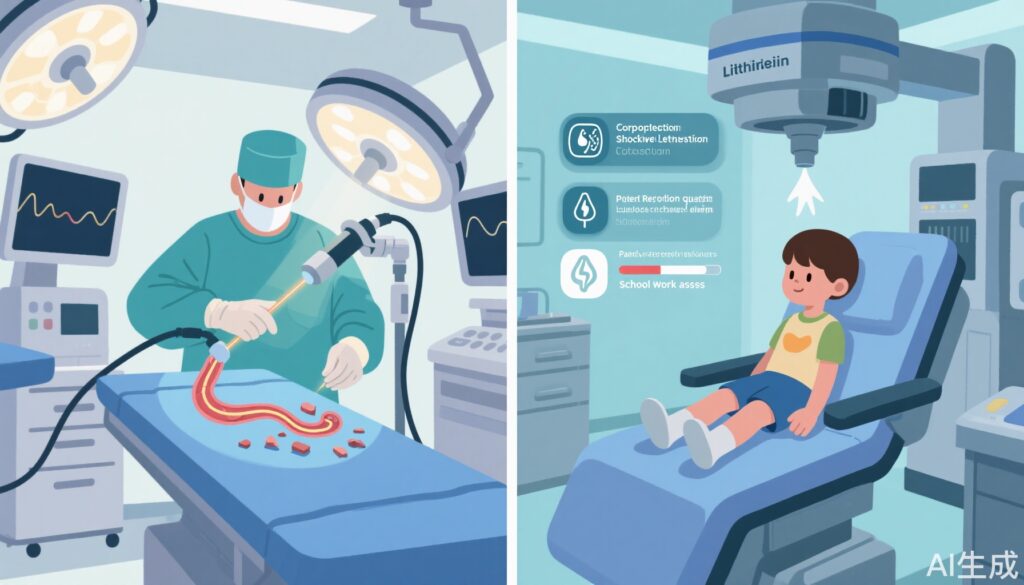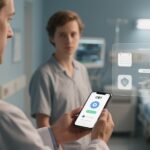Highlights
Ureteroscopy and shockwave lithotripsy (SWL) produced similar sonographic stone clearance at 6 (±2) weeks in this large nonrandomized trial of children and adolescents. SWL was associated with less short-term pain interference, fewer urinary symptoms, and substantially fewer missed school and caregiver workdays. High ureteral stent use with ureteroscopy may contribute to worse patient-reported outcomes.
Study background and disease burden
Kidney and ureteral stones are increasingly diagnosed in pediatric populations and carry acute morbidity (pain, renal colic, emergency visits) and long-term risks for recurrent stones and chronic kidney disease if not managed appropriately. In children and adolescents, definitive procedural options for symptomatic or obstructing stones typically include ureteroscopy (URS) and extracorporeal shockwave lithotripsy (SWL). Despite guideline statements generally supporting either modality depending on stone location, size, and local expertise, URS has become the dominant choice in many centers. Comparative effectiveness data in children have been limited by small sample sizes, single-center series, heterogeneous outcome definitions, and variable follow-up imaging modalities. The trial by Tasian et al. (JAMA Netw Open, 2025) addresses this evidence gap with a large multicenter cohort focused on clinically relevant outcomes including sonographic stone clearance and patient-reported symptom burden.
Study design
This was a pragmatic, nonrandomized clinical trial conducted at 31 US and Canadian centers between March 16, 2020, and July 31, 2023, with final follow-up completed October 15, 2023. Inclusion criteria were patients aged 8–21 years with kidney stones, ureteral stones, or both, chosen for definitive intervention with URS or SWL. The cohort comprised 1,142 patients (953 URS, 189 SWL) treated by 124 urologists. The primary outcome was stone clearance assessed by standardized ultrasonography at 6 (±2) weeks post-procedure, analyzed per kidney or ureter. To adjust for nonrandom treatment allocation, the investigators used inverse probability weighting with random intercepts for site in logistic regression models to estimate procedure-specific stone clearance rates and treatment effect. Secondary outcomes included patient-reported outcomes (pain interference T-scores, urinary symptom scores), and social impact measures such as missed school and caregiver work in the first postoperative week.
Key findings
Primary outcome: Stone clearance
– Stone clearance by standardized ultrasound at ~6 weeks occurred in 474 of the URS group (71.2%; 95% CI, 63.8%–78.5%) and in 105 of the SWL group (67.5%; 95% CI, 61.0%–74.1%).
– The risk difference was 3.6% (95% CI, –6.2% to 13.5%), a difference that was not statistically significant and not clinically meaningful.
Procedural context and procedural differences
– Median stone size was 6.0 mm (IQR, 4.0–9.0 mm). A total of 1069 kidneys/ureters were treated with URS and 197 with SWL across the cohort.
– Ureteral stent placement at the index procedure differed markedly by modality: stents were used in 841 procedures for URS (80.4% of URS patients) compared with only 6 procedures for SWL (2.6% of SWL patients). This large disparity is a potential mediator of patient-reported symptoms.
Patient-reported outcomes and social impact
– Pain interference 1 week after surgery was higher after URS: T‑score difference 5.0 (95% CI, 2.3–7.8) compared with SWL.
– Urinary symptom scores favored SWL as well: symptom score difference 3.9 (95% CI, 1.2–6.7) in favor of SWL.
– School absenteeism: Patients undergoing URS missed school more frequently in the week after surgery (risk difference 21.3%; 95% CI, 9.7%–32.8%).
– Caregiver work impact: Caregivers of URS patients missed work more often (risk difference 23.0%; 95% CI, 11.0%–35.0%).
Safety and other outcomes
– The trial text emphasizes patient‑reported outcomes rather than detailed perioperative complication rates in the abstract. The large difference in stent use suggests that stent-related symptoms may explain part of the higher pain and urinary symptom burden with URS. The ultrasound-based clearance endpoint minimizes radiation exposure but is less sensitive than CT for small residual fragments.
Clinical interpretation
– For a pediatric population with a median stone size of ~6 mm and a predominance of renal and ureteral stones, SWL achieved stone clearance rates similar to URS at 6 weeks. When balancing outcomes that matter to patients—pain, urinary symptoms, missed school and caregiver work—SWL had a favorable short-term profile. The high rate of ureteral stenting with URS likely contributed to increased postoperative pain and urinary symptoms, which is consistent with prior literature showing stent-related morbidity.
Expert commentary
The trial provides high-quality real-world evidence from many centers and operators, increasing external validity compared with single-center series. The pragmatic nonrandomized design using inverse probability weighting is an appropriate approach to address treatment selection bias when randomization is infeasible; however, residual confounding remains possible. Key limitations clinicians should consider include:
– Treatment allocation was not randomized. Although advanced statistical weighting was applied, unmeasured confounders (anatomical factors, surgeon judgment about stone composition, patient preference) may influence both procedure choice and outcome.
– Marked imbalance in ureteral stenting between groups. Stent placement is a likely mediator of increased pain and urinary symptoms after URS; the study cannot fully parse the independent effect of the endoscopic procedure versus the stent.
– Outcome measurement by ultrasound at 6 weeks favors patient safety (no CT radiation) but is less sensitive to small residual fragments; longer-term passage or growth of residual fragments was not reported in the abstract.
– The cohort demographics show underrepresentation of certain racial groups (e.g., small proportion of Black participants), raising questions about generalizability across populations.
How this fits with guidelines and prior evidence
– Historically, guidelines have endorsed individualized selection of URS or SWL in children, considering stone size, location, composition, and local expertise. This trial challenges the prevailing preference for URS by demonstrating comparable short-term stone clearance and better short-term patient-reported outcomes with SWL in a large, contemporary pediatric cohort. The findings underscore the importance of shared decision-making and incorporating patient-centered outcomes (pain, school attendance, caregiver burden) into procedural choices.
Practice implications and decision making
– For small to moderate stones (median 6 mm in this study), clinicians should consider SWL as a first-line definitive option when the anatomy, stone composition (radiopaque vs radiolucent), and local equipment/personnel permit.
– Where URS is chosen, strategies to minimize stent-related morbidity—selective stenting, shorter stent dwell time, use of smaller stents or stentless approaches when safe—should be emphasized.
– Shared decision-making should include discussion of expected stone clearance, the potential need for secondary procedures, stent-related symptoms, and the social impact (school and caregiver work absence).
Conclusion
In this large multicenter nonrandomized trial of children and adolescents with renal and ureteral stones, ureteroscopy and shockwave lithotripsy produced similar sonographic stone clearance at about 6 weeks. SWL was associated with less early pain, fewer urinary symptoms, and substantially fewer missed school and caregiver workdays—outcomes that are highly relevant for pediatric patients and families. These results should prompt clinicians and guideline panels to re-evaluate the routine preferential use of URS in pediatric stone disease and to prioritize individualized, patient-centered procedural selection.
References
1. Tasian GE, Chu DI, Nelson CP, et al.; PKIDS Care Improvement Network. Ureteroscopy vs Shockwave Lithotripsy to Remove Kidney Stones in Children and Adolescents: A Nonrandomized Clinical Trial. JAMA Netw Open. 2025 Aug 1;8(8):e2525789. doi:10.1001/jamanetworkopen.2025.25789 IF: 9.7 Q1 . PMID: 40773197 IF: 9.7 Q1 ; PMCID: PMC12332628 IF: 9.7 Q1 .2. ClinicalTrials.gov. NCT04285658. (Trial registration as reported in the manuscript.)



